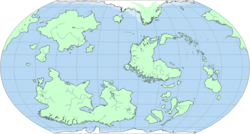Gaia
Jump to navigation
Jump to search

 | |
| Designations | |
|---|---|
| Pronunciation | // |
| Orbital characteristics[1] | |
| Aphelion | 1.445 AU |
| Perihelion | 1.444 AU |
| Semi-major axis | 1.44 AU |
| Eccentricity | 0.0167 |
| Orbital period | 587.695 days, 1.60899 years |
| Average orbital speed | ? |
| Satellites | 1 |
| Physical characteristics | |
| Mass | 0.99 Earths |
Rotation: 27.9 hours
Chronology[edit | edit source]
Geologic History[edit | edit source]

The 8 continents of Gaia: Dateline, Island Chain, Antarctic, Arctica, Originalia, Seforma, Omoserica, Archipelago
(Age of the World - 3.22 billion years)
A timeline of world history, beginning with the formation of our home planet.
First Eon (3210 mya - 2710 mya)[edit | edit source]
- Formation of the World and its Moon from the accretion disk around the young star. The other planets begin to form around this time, as well.
- The oldest known minerals appear, while the oldest known rocks date back to c. 2830 mya.
- The first life forms and self-replicating RNA molecules evolve.
- Late Heavy Bombardment period ends c. 2790 mya.
- Photosynthesis begins in microscopic primordial life c. 2710 mya.
Second Eon (2710 mya - 1980 mya)[edit | edit source]
- Simple single-celled life begins to form.
- First known oxygen producing bacteria, the atmosphere later becomes oxygenic.
- The first complex single-celled life, protists with nuclei form. The first super-continent (Unnamed) forms on the surface of the world.
Third Eon (1980 mya-500 mya)[edit | edit source]
- The first major super-continent (Unnamed) forms on the surface of the world, and persists for several hundred million years, before finally breaking up towards the end of the Third Eon.
- Multi-cellular eukaryotic life begins to form.
- The first "Snowball World" period; ice covers the world for two hundred million years before finally receding following a major period of volcanic eruptions and meteor impacts.
- By the end of this eon, life flourishes wordwide in the seas, and life begins to make the jump to land.
Fourth Eon (500 mya - present)[edit | edit source]
- Major diversification and expansion of life in the (ATL Unnamed Cambrian Explosion). Numerous fossils, most modern forms of life emerge in the Fourth Eon.
- Two major super-continents have formed and divided during this period: The first (Unnamed ATL Pannotia) forms c. 490 mya, before dividing c. 330 mya. The second, (Unnamed ATL Pangaea) forms c. 200 mya, before dividing c. 75 mya.
- The second "Snowball World" event; triggers a mass extinction as most life becomes extinct in the face of tremendously colder climates and growing ice caps. Ends c. 320 mya.
- Late Fourth Eon extinction event c. 90 mya. Leaves a large crater north of the (Unnamed Southern Archipelago)
Current Date: Emergence of Humanity & The Current Glacial Maximum. Fourth Eon, Third Era. (4.3 Eo)
Age Conversions Gaia Years (Earth-Years)
0-6 (0-11) Childhood 6-9 (11-17) Adolescence 9-20 (17-37) Young Adulthood 20-30 (37-56) Middle Age 30 + (56+) Old Age
- ↑ Osculating Orbital Elements